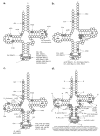A Census and Categorization Method of Epitranscriptomic Marks
- PMID: 32630140
- PMCID: PMC7370119
- DOI: 10.3390/ijms21134684
A Census and Categorization Method of Epitranscriptomic Marks
Abstract
In the past few years, thorough investigation of chemical modifications operated in the cells on ribonucleic acid (RNA) molecules is gaining momentum. This new field of research has been dubbed "epitranscriptomics", in analogy to best-known epigenomics, to stress the potential of ensembles of RNA modifications to constitute a post-transcriptional regulatory layer of gene expression orchestrated by writer, reader, and eraser RNA-binding proteins (RBPs). In fact, epitranscriptomics aims at identifying and characterizing all functionally relevant changes involving both non-substitutional chemical modifications and editing events made to the transcriptome. Indeed, several types of RNA modifications that impact gene expression have been reported so far in different species of cellular RNAs, including ribosomal RNAs, transfer RNAs, small nuclear RNAs, messenger RNAs, and long non-coding RNAs. Supporting functional relevance of this largely unknown regulatory mechanism, several human diseases have been associated directly to RNA modifications or to RBPs that may play as effectors of epitranscriptomic marks. However, an exhaustive epitranscriptome's characterization, aimed to systematically classify all RNA modifications and clarify rules, actors, and outcomes of this promising regulatory code, is currently not available, mainly hampered by lack of suitable detecting technologies. This is an unfortunate limitation that, thanks to an unprecedented pace of technological advancements especially in the sequencing technology field, is likely to be overcome soon. Here, we review the current knowledge on epitranscriptomic marks and propose a categorization method based on the reference ribonucleotide and its rounds of modifications ("stages") until reaching the given modified form. We believe that this classification scheme can be useful to coherently organize the expanding number of discovered RNA modifications.
Keywords: RNA modifications; epigenetic regulation; epitranscriptome; epitranscriptomics; gene-expression regulation; post-transcriptional regulation.
Conflict of interest statement
The authors declare no conflict of interest.
Figures





References
-
- Davis F.F., Allen F.W. Ribonucleic Acids from Yeast Which Contain a Fifth Nucleotide. J. Biol. Chem. 1957;227:907–915. - PubMed
Publication types
MeSH terms
Substances
LinkOut - more resources
Full Text Sources
Miscellaneous

